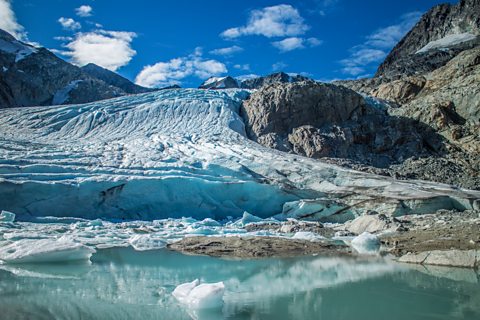What do you know?
Where are glaciers found?
There are glaciers on every continent except Australia. They are found in the coldest places, in Polar regions and on mountains.
Key points
- Glaciers can form distinct landforms through erosion of the landscape such as corries.
- Glaciers also deposit material to form unique landforms such as drumlins.
- Glaciated landscapes are a source of economic activity but also of conflict.
What is a glacier?
Glaciers are large masses of ice shaped like rivers. They flow like rivers, only much more slowly. As glaciers move, they wear away the land around them through a process called erosionWhere rocks are worn away, in this case by the movement of the glacier.. The eroded material is then transportationWhen material (rocks, sand and soil) is moved from one place to another by the glacier. by the glacier before finally being deposititionThe dropping off of sediment (rocks, sand and soil) as the glacier melts., or âdropped offâ.
Glacial landformsA feature on the Earthâs surface. are formed as a result of the erosion and deposition process. There are lots of glacial landforms that can be found in the UK, for example in Snowdonia in Wales.
Glacial landforms created by erosion
For some glacial landforms, the main process involved is erosion.
Glacial troughs
Rivers cut V-shaped valleys through the process of erosion. As rivers in their upper course donât have that much power, they are forced to wind between harder rock leaving ridges of land jutting out. These are called interlocking spursRidges of rock that stick out that a river flows around in a V-shaped valley. When viewed from downstream, these spurs appear to be locked together.. Glaciers bulldozeWhere ice pushes and moves material in front of it. through these valleys making them into distinctive U shapes with flat floors and steep sides called U-shaped valleys, cutting through the interlocking spurs, turning them into truncated spursA rounded area of land at the edge of a U-shaped valley..
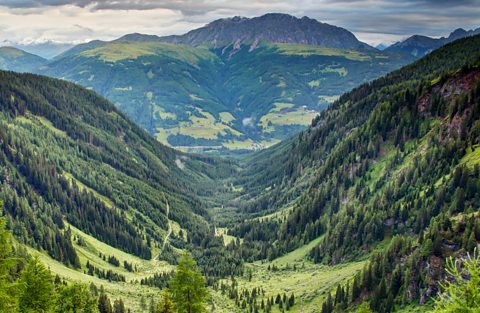
Once the ice has melted, long narrow lakes known as ribbon lakes can sometimes be formed. They may be created in an area where there is hard rock and softer rock. The hard rock does not get eroded but the softer rock does. moraineRocks and materials that a glacier has picked up, transported and then deposited. from the melting glacier forms a dam in the valley and water fills up behind.
Corries
Corries are bowl-shaped hollowA hole or depression in something. found on the side of a mountain. They form when the glacier deepens an existing hollow through freeze-thawWhen water in rocks freezes and expands, breaking the rock apart. action and pluckingA type of glacial erosion that occurs when ice freezes onto the landscape, ripping out rocks when it moves..
As the ice moves down the mountain it does so in a circular motion which further deepens the hollow, leaving a lip at the end. When the ice melts this hollow can fill with water. These are now called corrie lakes or tarns. An example of a corrie lake is Red Tarn in the Lake District.
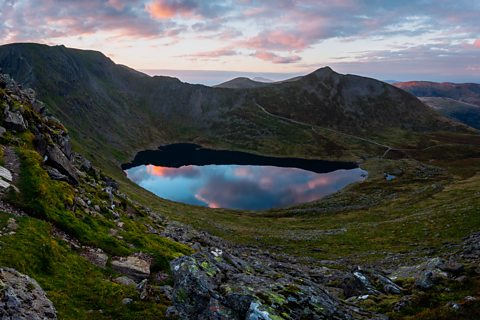
How corries are formed
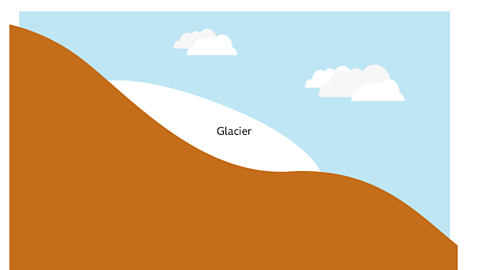
Image caption, The glacier deepens an existing hollow through freeze-thaw action and plucking
Image caption, The ice moves in a circular motion down the mountain which further deepens the hollow, lateral deposition is left in the form of moraines
Image caption, The ice melts and forms a lake called corrie lakes or tarns
1 of 3
ŽĄ°ùĂȘłÙ±đ
If corries form back-to-back on a mountain, they wear it away from both sides forming a knife edge called an arĂȘte.
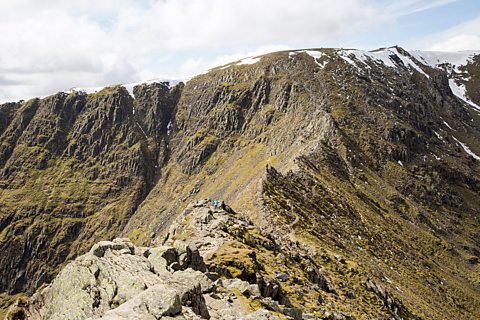
Pyramidal peak
If there are three or more corries and arĂȘtes back-to-back, a pyramidal peak can form. This is a sharply pointed mountain peak.
The Matterhorn on the border between Switzerland and Italy is an example of a pyramidal peak.
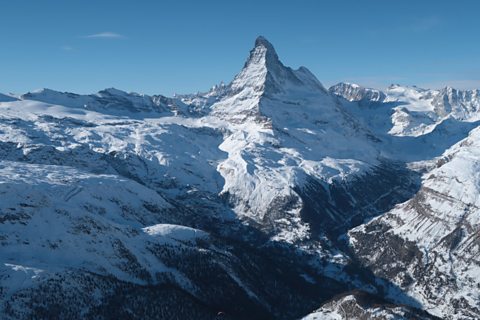
What is the name of the knife edge ridge formed by two back-to-back corries?
The name of the knife edge ridge formed by two back-to-back corries is an arĂȘte.
Glacial landforms created by deposition
Glaciers are very powerful and capable of carrying large amounts of rock. Eventually these will be dropped off by the glacier creating distinct landformsA feature on the Earthâs surface..
Deposition
Deposition happens when material transported by the glacier is deposited and left behind as the glacier melts or moves on.
Moraine
As the glacier moves down the mountain the air gets warmer. This causes the glacier to begin to melt. At this point everything carried by the glacier is deposited. This material is known as moraine.
There are four types of moraine:
- Terminal moraine is moraine deposited at the end of the glacier.
- If the whole glacier melts, for example as a result of climate change, then all the material is deposited. This is known as ground moraine.
- Lateral moraines are found deposited along the sides of the glacier.
- Medial moraines are found at the junction between two glaciers.
Types of glacial moraine
Drumlin
A drumlin is a long oval hill in the shape of a spoon made of glacial deposits. No one is really sure how drumlins form but it is thought it is caused by the ice becoming overloaded with sedimentSmall fragments of rocks and soil. which leads to it being deposited.
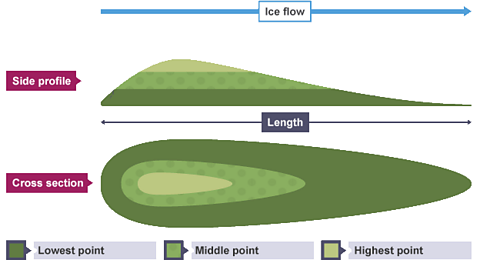
Erratic
Erratics are large rocks or boulders that are often found on their own. These rocks have been transported, sometimes over long distances, before being dropped off.
What is an erratic?
An erratic is a large rock or boulder that has been transported and deposited by a glacier.
How glaciated areas are used
Glaciated areas have many uses that can provide benefits to the area but can also lead to challenges.
Tourism
The landscapes created by glaciation attract tourists. The mountains provide a place where people can take part in activities such as mountain climbing, hiking and mountain biking and the lakes provide the opportunity for water sports. Sometimes tourism can cause disagreements. Local people are sometimes concerned that tourists cause traffic congestion, littering and damage whilst also pushing up house prices by buying second homes.
Farming
Although the harsh conditions of mountainous areas make most types of farming difficult, sheep farming is a common activity. Although farmland may seem like a natural environment with the green fields, they are in fact man-made. Some people believe that sheep and the clearing of the land for farming should be stopped and the land rewildingActivities undertaken to restore natural habitats to their original state..
Forestry
Another common use of land in glaciated areas is for forestry. This is where trees are grown to be used for timber. coniferousEvergreen trees such as pine trees. trees are adapted to cope with cold conditions and are perfect for uplandAn area of high land. areas. Although planting trees is good for the environment, logging companies will often only plant one type of tree leading to limited biodiversityThe variety of different plants and animals in an area. in the area.
Quarrying
Glacial areas often contain large amounts of valuable hard rock. Quarrying takes place to extract rock such as limestone to be used for construction. This causes visual pollution as views are spoilt, noise pollution from the heavy machinery and damages habitats.
What sorts of activities take place for tourists in glaciated areas?
Climbing, hiking, mountain biking and water sports are some activities that take place in glaciated areas.
Test your knowledge
Play the Planet Planners game! gamePlay the Planet Planners game!
Make decisions for the planet in this KS3 geography game.

More on Glaciation
Find out more by working through a topic
- count1 of 2
